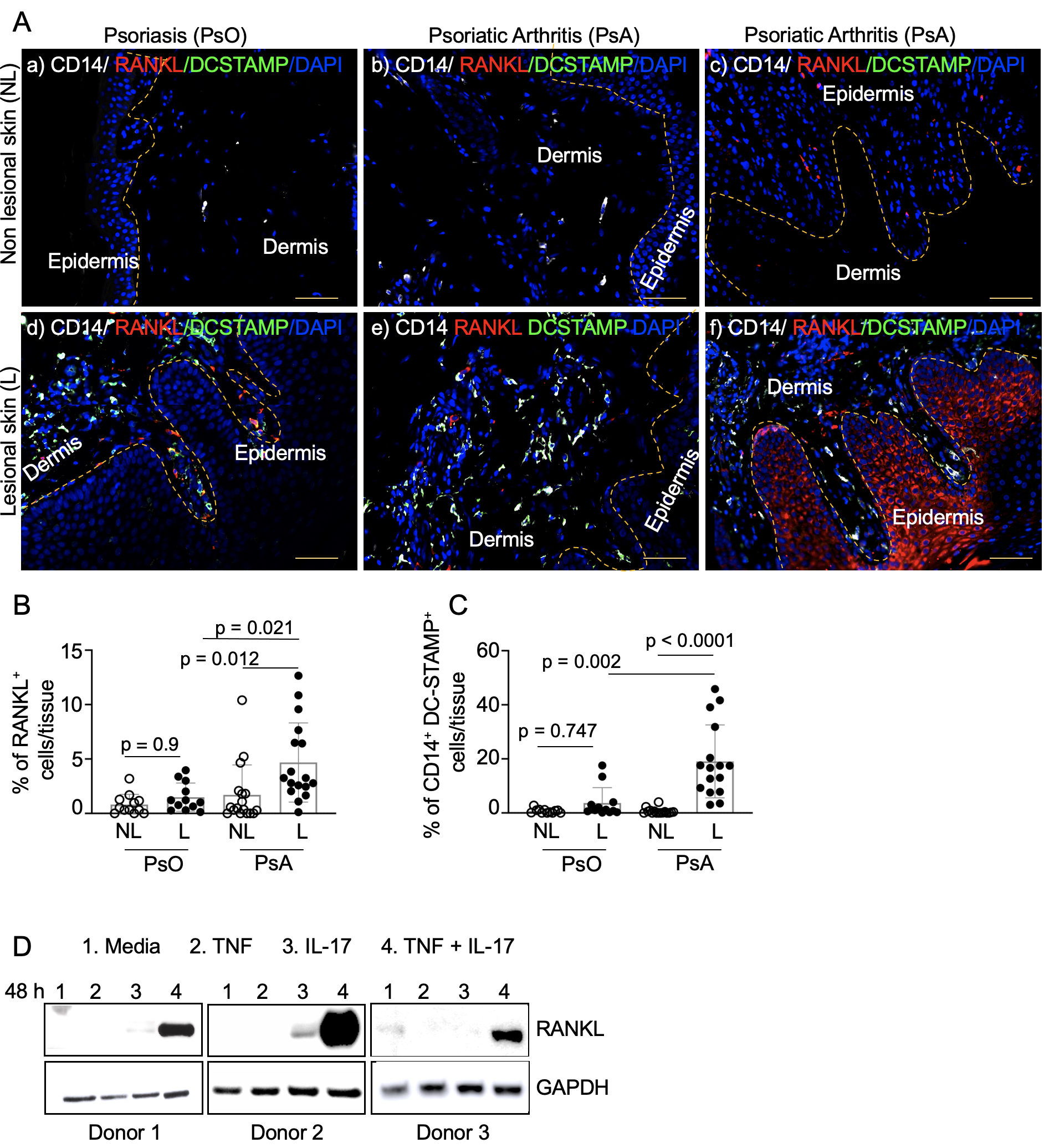Session Information
Date: Tuesday, November 14, 2023
Title: Abstracts: Spondyloarthritis Including Psoriatic Arthritis – Basic Science
Session Type: Abstract Session
Session Time: 2:00PM-3:30PM
Background/Purpose: Psoriatic arthritis (PsA) is a chronic inflammatory disease that affects the skin and joints. Circulating Osteoclast precursors (OCP) are elevated in the blood of PsA patients and express Dendritic Cell-Transmembrane Protein (DC-STAMP), a protein essential for cell-cell fusion. Receptor Activator of Nuclear Factor kB Ligand (RANKL) is a pivotal effector driving osteoclastogenesis and is elevated in psoriatic synovium. Herein, we examined skin from PsO and PsA patients to determine if events in the skin trigger the differentiation of monocytes to OCPs.
Methods: We collected lesional (L) and non-lesional (NL) skin biopsies from 23 patients with Ps and 16 patients with PsA. We applied immunofluorescence to visualize and enumerate DC-STAMP+ monocytes, CD3+ TNF+ IL17+ cells and RANKL expression by dermal-infiltrating immune cells and keratinocytes. We also evaluated RANKL expression in CD45– skin cell suspension by flow cytometry and the induction of RANKL in keratinocytes activated with IL-17 and TNF by western blot analysis.
Results: We found significantly higher RANKL mRNA expression (PsA: 16.67-fold vs PsO: 1.7-fold, p = 0.001) and infiltration by RANKL+ cells in PsA compared to PsO skin (PsA: 4.8% vs PsO: 2% p = 0.022). In addition, 43.75% of PsA L skin have RANKL expression in the epidermal cells but not PsO lesional skin biopsies. Skin cell suspensions showed higher RANKL+ non-hematopoietic cells in L skin, compared to NL skin. We also found an increased number of dermal DC-STAMP+CD14+ OCP in the dermis of PsA plaques. CD3+ T and IL17+ cells were less abundant in PsA, compared to PsO L skin. We detected a higher TNF concentration in sera from PsA patients than Ps. Furthermore, incubation with both TNF and IL17, but not TNF or IL-17 alone, strongly induced RANKL expression on keratinocytes.
Conclusion: We find infiltration of DC-STAMP+CD14+ OCP in the skin of PsA but not Ps patients. Also, increased systemic TNF levels in PsA patients combined with IL17 upregulates RANKL+ protein expression by non-hematopoietic cells. Thus, expression of RANKL by monocytes and keratinocytes in plaques of PsA patients demonstrate the ability to promote RANKL-dependent priming of OCP.
To cite this abstract in AMA style:
Garcia-Hernandez M, Yoshida T, Rangel-Moreno J, Lieberman A, Paine A, Weitz J, Tausk F, Beck L, Ritchlin C. Upregulation of RANKL in the Skin of Patients with Psoriatic Arthritis [abstract]. Arthritis Rheumatol. 2023; 75 (suppl 9). https://acrabstracts.org/abstract/upregulation-of-rankl-in-the-skin-of-patients-with-psoriatic-arthritis/. Accessed .« Back to ACR Convergence 2023
ACR Meeting Abstracts - https://acrabstracts.org/abstract/upregulation-of-rankl-in-the-skin-of-patients-with-psoriatic-arthritis/

